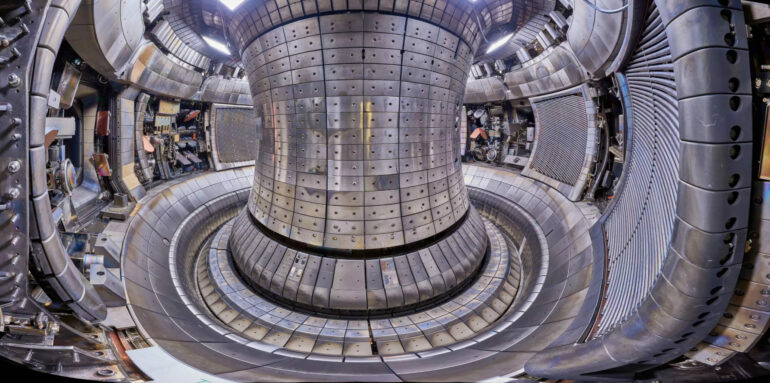A magnetic cage keeps the more than 100 million degree Celsius hot plasmas in nuclear fusion devices at a distance from the vessel wall so that they do not melt. Now researchers at the Max Planck Institute for Plasma Physics (IPP) have found a way to significantly reduce this distance. This could make it possible to build smaller and cheaper fusion reactors for energy production. The work was published in the journal Physical Review Letters.
The international experimental reactor ITER, which is currently being built in southern France, represents the most advanced way to generate energy in a fusion power plant. The design follows the tokamak principle, i.e., a fusion plasma at more than 100 million degrees is confined in a magnetic field shaped like a donut. This concept prevents the hot plasma from coming into contact with the enclosing wall and damaging it. The ASDEX Upgrade tokamak experiment at IPP in Garching near Munich serves as a blueprint for ITER and later fusion power plants. Important elements for ITER were developed here. And plasma operating conditions and components for later power plants can already be tested today.
The hot plasma moves closer to the divertor
A central element of ASDEX Upgrade and all modern magnetic fusion facilities is the divertor. This is a part of the vessel wall that is particularly heat-resistant and requires an elaborate design. “At the divertor arrives the heat from the plasma at the wall. In later power plants, the fusion product helium-4 will also be extracted there,” Prof. Ulrich Stroth explained, head of the Plasma Edge and Wall Division at IPP. “In this region, the wall load is particularly high.” The divertor tiles of ASDEX Upgrade and also of ITER are therefore made of tungsten, the chemical element with the highest melting temperature of all (3422°C).
Without countermeasures, 20% of the fusion power of the plasma would reach the divertor surfaces. At approx. 200 megawatts per square meter, that would be roughly the same conditions as on the surface of the sun. However, the divertor in ITER and also future fusion power plants will only be able to cope with a maximum of 10 megawatts per square meter. For this reason, small amounts of impurities (often nitrogen) are added to the plasma. These extract most of its thermal energy by converting it into ultraviolet light. Nevertheless, the plasma edge (the separatrix) must be kept at a distance from the divertor to protect it. In ASDEX Upgrade until now, this has been at least 25 centimeters (measured from the lower plasma tip—the X-point—to the edges of the divertor).
X-point radiator opens up new possibilities for fusion reactor design
Now, researchers at IPP have succeeded in reducing this distance to fewer than 5 centimeters without damaging the wall. “We specifically use the X-point radiator for this, a phenomenon we discovered about a decade ago during experiments at ASDEX Upgrade,” IPP researcher Dr. Matthias Bernert said. “The X-point radiator occurs in specifically shaped magnetic cages when the amount of added nitrogen exceeds a certain value.”
This leads to formation of a small, dense volume that radiates particularly strongly in the UV range. “Such impurities give us somewhat poorer plasma properties, but if we set the X-point radiator to a fixed position by varying the nitrogen injection, we can run the experiments at higher power without damaging the device/divertor,” Dr. Bernert explained.
In camera images from the vacuum vessel, the X-point radiator (XPR for short) can be seen as a blue glowing ring in the plasma, as it also emits some visible light in addition to the UV radiation. IPP researchers have recently intensively investigated the XPR. Nevertheless, chance also played a role in the current discovery: “We accidentally moved the plasma edge much closer to the divertor than we had intended,” IPP physicist Dr. Tilmann Lunt said.
“We were very surprised that ASDEX Upgrade coped with this without any problems.” Because the effect could be confirmed in further experiments, the researchers now know: when the X-point radiator is present, significantly more thermal energy is converted into UV radiation than previously assumed. The plasma then radiates up to 90% of the energy in all directions.
Fusion power plants could be built more compact and cheaper
This leads to conclusions that could be very favorable for the construction of future fusion power plants:
Divertors can be built smaller and technologically much simpler than before (Compact Radiative Divertor).Because the plasma moves closer to the divertor, the vacuum vessel volume can be better utilized. Initial calculations show that if the vessel were optimally shaped, it would be possible to almost double the plasma volume while maintaining the same dimensions. This would also increase the achievable fusion power. But the researchers first have to verify this in further experiments.
In addition, the use of the X-point radiator also helps against edge localized modes (ELMs): violent energy eruptions at the plasma edge that recur at regular intervals and expel about a tenth of the plasma energy towards the wall. ITER and future fusion reactors would be damaged by such eruptions.
“We are dealing with a significant discovery in fusion research,” is therefore also the verdict of IPP Division Director Ulrich Stroth. “The X-point radiator opens up completely new possibilities for us in the development of a power plant. We will further investigate the theory behind it and try to understand it better by new experiments at ASDEX Upgrade.” The Garching tokamak will soon be ideally equipped for this: By summer 2024, it will be provided with a new upper divertor. Its special coils will make it possible to deform the magnetic field close to the divertor freely and thus also optimize the conditions for the X-point radiator.
More information:
T. Lunt et al, Compact Radiative Divertor Experiments at ASDEX Upgrade and Their Consequences for a Reactor, Physical Review Letters (2023). DOI: 10.1103/PhysRevLett.130.145102
Provided by
Max Planck Society
Citation:
New discovery points the way to more compact fusion power plants (2023, April 11)



